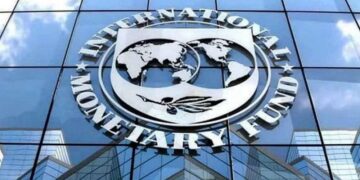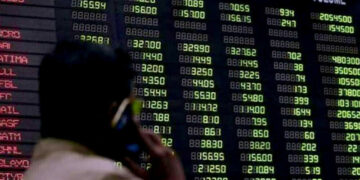 The Real GDP is estimated to grow at 2.4pc on the back of strong performance of services sector as against actual growth of 3.8pc last year and target of 4.5pc.The growth in the agriculture is estimated at 1.2pc on the back of 3.7pc growth in the livestock sector.- Major Crops accounting for 31.1pc of agricultural value added registered negative growth of 4.0pc compared to a negative growth of 2.4pc last year and a target of 3.7pc.- Minor crops registered a growth rate of 4.8pc compared to the target of 3.0pc and massive negative growth of 7.8pc last year.- Output in the manufacturing sector has witnessed expansion of 3pc in 2010-11 as compared to expansion of 5.5pc last year on the back of strong performance from small and medium manufacturing sector.– Large-scale manufacturing grew by 0.98pc (July-February 2010-11 incorporated in the national accounts but the growth is now 1.7pc in July-March 2010-11) as against 4.9pc of last year.- The services sector grew by 4.1pc against the target of 4.7pc and actual outcome of 2.9pc. Within services sector Wholesale and retail trade sector grew at 3.9pc as compared to 4.6pc last year and the target for the year of 5.1pc. Finance and insurance sector recorded negative growth of 6.3pc in 2010-11 as against contraction of 11.3pc last year. Public administration and defense posted a stellar growth of 13.2pc as compared to 2.5pc in last year. Social Services Sector grew by 7.1pc which is slightly higher than the target of 5.0pc but lower than last year’s actual growth of 7.8pc.
The Real GDP is estimated to grow at 2.4pc on the back of strong performance of services sector as against actual growth of 3.8pc last year and target of 4.5pc.The growth in the agriculture is estimated at 1.2pc on the back of 3.7pc growth in the livestock sector.- Major Crops accounting for 31.1pc of agricultural value added registered negative growth of 4.0pc compared to a negative growth of 2.4pc last year and a target of 3.7pc.- Minor crops registered a growth rate of 4.8pc compared to the target of 3.0pc and massive negative growth of 7.8pc last year.- Output in the manufacturing sector has witnessed expansion of 3pc in 2010-11 as compared to expansion of 5.5pc last year on the back of strong performance from small and medium manufacturing sector.– Large-scale manufacturing grew by 0.98pc (July-February 2010-11 incorporated in the national accounts but the growth is now 1.7pc in July-March 2010-11) as against 4.9pc of last year.- The services sector grew by 4.1pc against the target of 4.7pc and actual outcome of 2.9pc. Within services sector Wholesale and retail trade sector grew at 3.9pc as compared to 4.6pc last year and the target for the year of 5.1pc. Finance and insurance sector recorded negative growth of 6.3pc in 2010-11 as against contraction of 11.3pc last year. Public administration and defense posted a stellar growth of 13.2pc as compared to 2.5pc in last year. Social Services Sector grew by 7.1pc which is slightly higher than the target of 5.0pc but lower than last year’s actual growth of 7.8pc.
– Pakistan’s per capita real income has risen by 0.7pc in 2010-11 as against 2.9pc last year. – Per capita income in dollar term rose from $ 1073 last year to $ 1254 in 2010-11, thereby showing tremendous increase of 16.9pc. This is mainly because of stable exchange rate as well as higher growth in nominal GNP.- Real private consumption rose by 7.0pc as against 4.0pc attained last year. However, gross fixed capital formation lost its strong growth momentum and real fixed investment growth contracted by 0.4pc as against the contraction of 6.1pc in last fiscal year. The total investment has declined from 22.5pc of GDP in 2006-07 to 13.4pc of GDP in 2010-11. Fixed investment has decreased to 11.8pc of GDP from 13.4pc last year.- The national savings rate has decreased to 13.8pc of GDP in 2010-11 as against 15.4pc of GDP last year. Domestic savings has also declined substantially from 16.3pc of GDP in 2005-06 to 9.5pc of GDP in 2010-11.
AGRICULTURE
– The agriculture growth this year is estimated at 1.2pc as compared with 0.6pc during 2009-10.- Cotton production has decreased from 12,913 thousand bales in 2009-10 to 11,460 thousand bales in 2010-11, showing a decrease of 11.3pc. Wheat production has increased from 23,311 thousand tons in 2009-10 to 24,214 thousand tons in 2010-11, showing an increase of 3.9pc.- Rice production has decreased from 6,883 thousand tons in 2009-10 to 4,823 thousand tons in 2010-11, showing a decrease of 29.9pc. Sugarcane production has increased by 12pc to 55.3 million tons in 2010-11 from 49.4m tons last year.- Gram production has increased from 562 thousand tons in 2009-10 to 523 thousand tons in 2010-11, showing a decrease of 6.9pc.- Maize production has increased from 3,262 thousand tons in 2009-10 to 3,341 thousand tons in 2010-11, showing an increase of 2.4pc. In minor crops, the production of potato, onion and mash increased by 18.6pc, 11.2pc and 1.0pc, respectively. However, the production of mung, chillies and mash decreased by 35.5pc, 8.6pc and 2.7pc respectively.- Agriculture credit disbursement of Rs. 168.7 billion during July-March 2010-11 is higher by 1.4pc, as compared to Rs. 166.3 billion over the same period last year.
– The domestic production of fertilizers during the first nine months (July-March 2010-11) of the current.fiscal year was higher by 2.7pc as compared with corresponding period last year. On the other hand, the import of fertilizer decreased by 50.4pc, the off-take of fertilizer also decreased by 11.3 pc during the same period last year.
MANUFACTURING & MINING
– During the First nine months of the current Fiscal Year 2010-11, production of Large Scale Manufacturing (LSM) increased by 1.71pc which was mainly caused by the improvement in sub groups of leather (30pc), automobile (14.6pc), Food, Beverages & tobacco (9.3pc) and paper & board (2.9pc).- The items which show an increase in their production during this period were TV sets (28.6pc), sugar (26.5pc), LCVs (23.3pc) and cooking oil (9.7pc).- During the current fiscal year (2010-11), cement production decreased to 20.8 million ton as against 23.1 million tons last year showing a decrease of 9.6 %, whereas sugar production increased by 3.8 million ton showing an increase of 26.5pc.- Exports earning of the Textile products in 2010-11 (July-March) showing an increase of 29.9pc. – During 2010-11 (July-March) in automotive industry cars, LCVs/Jeeps and two/three wheelers registered a positive growth of 16.4pc, 20.5pc and 12.6pc, respectively.- The mining and quarrying sector is estimated to grow by 0.4pc in 2010-11 as against 2.2pc last year. Natural gas, crude oil and dolomite posted positive growth rate of 1.9pc, 1.1pc and 5.9pc, respectively.
FISCAL DEVELOPMENT
– Tax collection by the FBR was targeted at Rs 1667 billion for fiscal year 2010-11. However, the target was downward revised to Rs 1,588b, as a result of devastation caused by floods during July and August 2011.- The catastrophic floods reduced growth and posed a further challenge to public finances by depressing budget revenues and additional spending to meet the humanitarian and reconstruction needs, thereby upward adjustment in the fiscal deficit target from 4pc of GDP at the time of budget announcement to 5.3pc of GDP have made.- The government is focused on prudent expenditure management and better resource mobilization to create fiscal space for providing support to growth. Major reforms like harmonization of tax administration have taken place and strengthening of Risk Based Audit is under process.- Through a combination of Presidential Ordinance and withdrawal of SRO base exemptions, amendments have been made in the Sales Tax Act 1990, Income Tax Ordinance 2001 and Federal Excise Act 2005. The additional revenues of Rs 53 billion are estimated during the last quarter of 2010-11.- The following tax measures have been taken through these amendments:-i. Withdrawal of sales tax exemption on agriculture inputs like tractors, pesticides, and fertilizer both at domestic and import stages. Now these are subjected to 17pc GST ii. A one time surcharge of 15pc has been imposed on withholding and advance taxes payable during financial year 2011; and iii. Special excise duty rate has been increased from 1pc to 2.5pc on non-essential items for the remaining period of tax year 2010-11.
– The administrative measures and vigilance will be helpful in generating another Rs 24 billion. These steps will also be helpful in achieving the revised collection target of Rs 1588b.- Revenue collections of FBR stood at Rs 1,156 billion during July-April 2010-11, thereby reflecting 12.6pc growth over Rs 1,026.5 billion collected during the corresponding period last year. Among the four federal taxes, the highest growth 15.6 % has been recorded in sales tax receipts, followed by customs (12.6 %), direct tax (10.7 %) and federal excise (7.0%).- For July-April, 2011, direct taxes have been a major source of FBR tax revenue collection, contributing 37.1pc of total receipts. Net collection was estimated at Rs. 430 billion. Indirect taxes including (Sales Tax, Federal Excise Duty and Custom Duty) grew by 13.8pc during July-April, 2011 and accounted for 62.8pc of the total FBR tax revenue. Net collection was estimated at Rs.726.0b. Total expenditure of Rs. 3,257 billion was estimated for the full year, comprising of Rs. 2,641 billion of current expenditure (81.1% of total), and Rs. 617 billion of development expenditure (18.9% of total).
MONEY AND CREDIT
– SBP has raised the discount rate to 14pc on 30th November 2010, and decided to keep the rate unchanged at 14pc.- Net expansion in M2 increased by 9.62pc during July-April, 2011 as compared to 8.1pc during the same period last year – Net Domestic Assets (NDA) during July-April 2011 reached at Rs 402.5 billion against Rs 446.1 billion during the same period last year. The expansion in NDA mainly attributed by a rise in demand for private sector credit and government borrowings.- On the other hand the NFA of the banking system during the period under review stood at Rs 153.2 billion after registering a significant decline of Rs 31.3 billion during the same period of last year. – During July-April, 2011 Credit to private sector enterprises (PSEs) registered a sharp decline from Rs72.5b in 2009-10 to Rs 26.7 billion owing to the retirements by an oil refinery and a state owned oil marketing company .- The government borrowing from the banking system for budgetary support and commodity operations stood at Rs 342.2 billion during July-April, 2011. Government has borrowed Rs 196.3 billion from the SBP , while Rs 275.9 billion has been borrowed from the scheduled banks. In the month of May 2011, the govt has further reduced its borrowing stock from the SBP to attain the target of net zero borrowing from the SBP.
– During July-April 2010-11 the retirement of loans under commodity financing picked up sharply and reached at Rs 134.2 billion on account of retirement of advances for wheat by provincial departments and PAASCO and other provincial procurement agencies as compared to Rs 35.6 billion during the same period last year.- The credit availed by the private sector during July-April, 2011 was Rs 156.7 billion is compared to Rs 144.2 billion in the corresponding period last year.- A strong growth has been witnessed since January 2010 which was due to an increase in seasonal demand for working capital. More than half of private sector credit went to the textile sector showing higher input prices, especially cotton. Sector wise breakup of private sector credit also shows that sugar and textile industries were the major drivers to this increase, which respectively availed credit of Rs 105.6 billion and Rs 62 billion during Jul-March 2011.- Liquidity conditions in the money market remained fairly comfortable during July-March 2010-11 underpinned by the reduced govt borrowings from the SBP and growth in bank deposits. SBP drained this excess liquidity not only through auctions, but also mopped up a significant amount through open market operations (OMOs). – Nation












